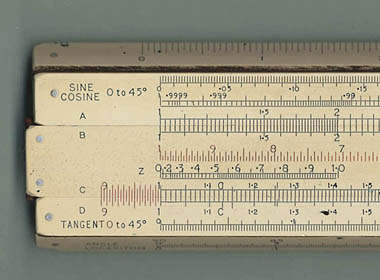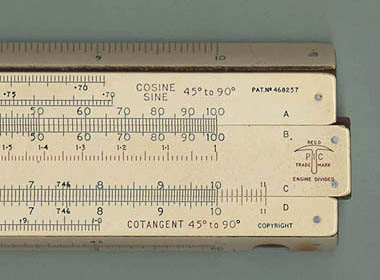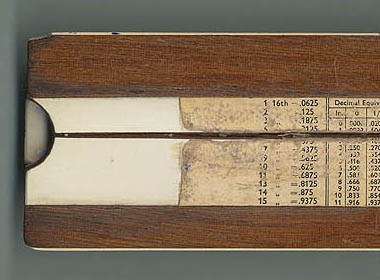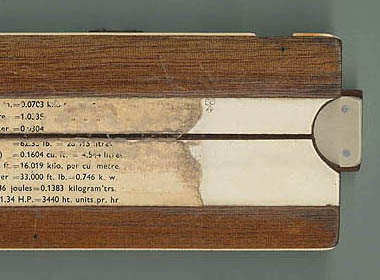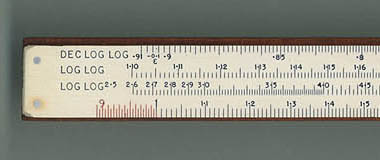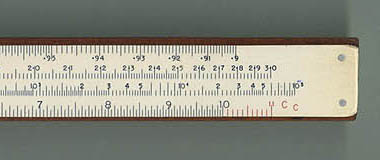|
This rule is designed for A.C. (alternating current) electrical engineering.
The scale set is somewhat similar with the Darmstadt rule but it has some
special scales. Below is a list of scales for this rule.
| Stator(Upper Bevel) |
0 - 10 inch |
| Stator(Upper) |
SIN (0 - 0.71)
COS (1- 0.70)
A (1 - 100) |
| Slide (Front) |
B (1 - 100)
CI (10 - 1)
Z (0 - 1.0) °C(0 - 100) °F(20 - 230) (Partial scales)
C (1 - 10, with extension) |
| Stator(Lower) |
D (1 - 10, with extension)
TANGENT (0 - 1.0) |
| Stator(Lower Bevel) |
ANGLE (0 - 45)
LOGARITHM (0 - 1.0) |
| Slide (Back) |
DEC LOG LOG (0.91 - 0.15, 0.98 - 0.9)
LOG LOG (1.10 - 3.0)
LOGLOG (2.5 - 10^5)
C (1 - 10, with extension)
|
- The most distinct feature of this rule is in its trig scales. SINE,
COSINE and TANGENT scales are located on the front side of
the stator. They are referenced by the ANGLE scale located at
the lower beveled portion. The Angle scale is a linear scale and 45
degrees coincides with 0.9 of the Logarithm scale. This enables both
scales to share the same linear tick marks.
- Sin, Cos and Tan scales are non-logarithmic and, therefore, values
cannot be used directly for subsequent calculations. However, greater
accuracy is achieved for Cosine value of smaller angles. This is especially
valuable for A.C. electrical power engineering since cosine is used
to calculate "phase factor " (or "power factor")
which is an indication of how well a power transmission system is utilized.
- °C and °F scales are used
to convert temperatures between Celsius and Fahrenheit using gauge marks
on the D scale. It is much like the unit conversion method found on
"Pilot's Watches."
- Z scale on the slider is used for calculation of hypotenuse
of the right angle triangles, i.e. c = sqrt(a2+b2).
(The author would like to thank Mr. Kubota for his input as to the use
of this scale.)
- The uppermost scale on the back of the slide is an inverse LL scale.
It is called DEC LOG LOG (Decimal Log-Log) because it is based on e/10.
This scale is referenced to A scale which enables to cover a wider range
of values. Furthermore, the scale for 0.98 - 0.905 is folded back to
the right-hand side to further expand the range.
|

